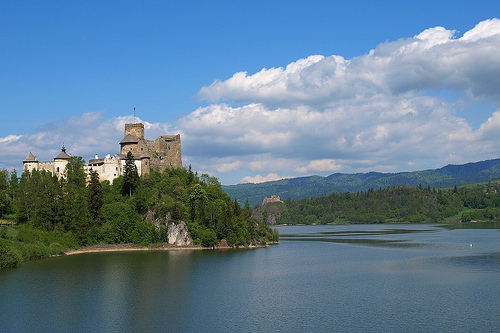

Location: Niedzica, Nowy Targ County Map
Constructed: 1320- 26
Castle Museum:
May- Sept: 9am- 7pm
Oct- Apr: 9am- 5pm Tue- Sun
Entrance Fee: 10 zl
Niedzica Castle is a medieval citadel in Niedzica,
Nowy Targ County in Poland. It was constructed in 1320- 26 on a rock
cliff overlooking Czorsztyn Lake. For the first time the name
Dunajec Castle (Latin: novum castrum de Dunajecz) appeared in a
document from 1325. The castle was registered as the property of Jan
and Rykolf Berzevicze, lords in Brzozowica. They were the
grandchildren of the Spis Rudesinger of Tyrol, who, after giving
King Hungary II Andrew II in 1209, founded Niedzica. After
Berzevicze as lords of the castle in Niedzica, in 1330 Wilhelm
Drugeth, the district of Spiš, was mentioned, followed by his
brother Mikołaj. In 1425, the entire the Dunajec key was in the
hands of Piotr Schwarz of Berzevicze, who was a sub-treasury of
Zygmunt Luxemburg. The feudal "Niedzica state" (the property of the
Niedzica castle) stretched throughout the whole of Zambia Spiskie.
Initially, this castle was a Hungarian watchtower on the border with
Poland.
Until 1470, the castle remained in the hands of the
descendants of Rudyger, and then it became the property of the Spisz
comer Emeryk Zapolya, the Spiš county, grandfather Barbara, the
Polish queen, the first wife of Sigismund the Old. His brother's
grandson, Jan Zápolya, count of Spis and voivode of Transylvania,
became the Hungarian king in 1526. He largely owed his victory in
the fight for the throne to the diplomacy of Hieronim Łaski, who in
gratitude in 1528 gave the poviat of conspiracy with Kieżmark,
Gelnica and the Dunajec key together with Niedzica.
For 60
years, the castle was owned by Łaski: Hieronim, and later his son
Olbracht. Known from the thriving lifestyle of Olbracht Grace, the
castle first pawned and sold it to Jerzy Horváth, who carefully
rebuilt it, transforming it into a magnificent Renaissance residence
(in large part it has survived to this day). Then the castle was
leased to the Italian-Hungarian Giovanelli family. It was a very
pious family who donated most of their money to religious buildings.
They were not interested in the castle, so he began to fall into
ruin. After the dying of the Giovanelli family, the castle passed
into the hands of Andrzej Horvath. The new owner rebuilt the
ballroom, which made the castle famous all over Hungary, because it
arranged numerous and grand balls. In 1858 the castle was taken over
by another Hungarian family - the Salamons.
After the end of
World War I, the castle was on Polish territory. It remained the
property of the Salamons until 1945. The last owner, Countess Ilona
Betheln Salamon, left for the last time in 1943. An important fact
from this period is the preservation in the castle estates until
1931 (the longest in Europe) of residual forms of serfdom. From
1948, restoration works and partial reconstruction were carried out
at the castle. In some of the rooms, the creative work house of the
Association of Art Historians was created, others were open to
visitors, creating a museum of interior and history of the Spis
region. In 1960, a seismological station of the Geophysics
Department of the Polish Academy of Sciences was arranged in the
tower.
One of the most mysterious pages in the history of the
castle is found, apparently just after World War II, Inca kipu - a
kind of writing information in a knot script, which contains
information about a hidden treasure.
Niedzicki Castle was the
location of many films. From March 1955, filming here for the movie
Revenge based on the comedy of Aleksander Fredro with 16-year-old
Beata Tyszkiewicz in the role of Klara. In 1967, a Polish war movie,
Crazy Night, was made in the rooms and the immediate vicinity of the
castle, based on the novel by Natalia Rolleczek. In 1975, Mazep's
film was made in the castle, based on the drama of Juliusz Słowacki.
The castle was also a place where photos were taken, among others to
the TV series Janosik and Holidays with the Ghosts. The object is
also a place of action in the adventure book Aga Paszkot Ciotka, bad
and Niedzickie Zamczeo. In 2011, he was also the seventh stop at The
Amazing Race Australia 2.
Today, the castle has museum and
hotel functions, being one of the biggest historical attractions of
the southern part of the Lesser Poland Voivodeship. An "alley" leads
to the castle. Behind the entrance gate and hall is the lower castle
courtyard. Within this part of the castle there are guest rooms. In
the museum part you can see the so-called Salamons chambers,
equipped with items from the 16th - 19th centuries. Wooden stairs
lead to the observation deck. Through the next gate leads the
entrance to the upper castle and to the castle dungeons, which
served as basements, as well as a prison (the so-called torture
chamber was established here). On the edge of the upper castle
courtyard there is a well carved in solid limestone rock with a
depth of over 60 m. In the upper chambers of the Lord's castle, you
can see: the hunting room, the salt chamber and the guard room.
On the opposite side of the Dunajec, over the lake's slope, are
the ruins of the castle in Czorsztyn.
Legends
According to
legend, the Incas resided in and around the castle at the end of the
18th century: descendants of Tupac Amaru II and part of the
aristocracy fleeing Spanish persecution. Within the castle, the Inca
fugitives were also to hide part of the treasury intended - probably
- to finance the uprising against Spain.